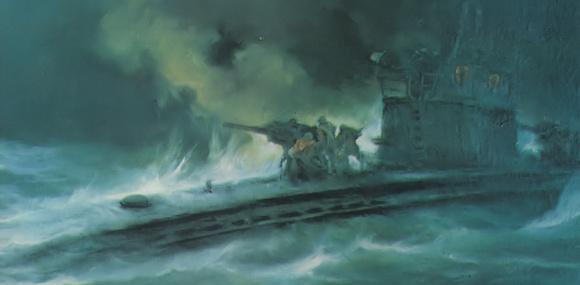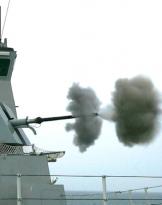In the new operational environment of the Atlantic, the attack on enemy traffic, obviously no longer tied to the group tactic of the "pack of wolves", was divided into many single actions against isolated merchant ships, actions in which the use of the cannon assumed importance preponderant.
That is, the tactical conditions that the Italian boats, due to their construction characteristics and training methods, had shown they were able to exploit effectively, were verified.
And finally the well-deserved successes that the Regia Marina badly needed arrived...

(Bordeaux November 19, 1941 - Vessel Captain Romolo Polacchini Superior Commander of Betasom, greets the submarine "Da Vinci" departing for its first Atlantic mission under the command of CC Luigi Longanesi Cattani)
In anticipation of an intense traffic existing in the areas of operation and of poor surveillance and defense, the vessel captain Romolo Polacchini recommended to the commanders of the five submarines also to pay particular attention in the economy of the torpedoes, resorting to the cannon to give the torpedoed ships the coup de grâce, so as to spare their precious torpedoes.
Considering then that the submarines Finzi, Tazzoli e Morosini, not too modern, had rather worn out machines and materials, and what Morosini, Da Vinci e Torelli would have faced for the first time an expected navigation of over 10.000 miles, particular attention was paid to the modification, verification and overhaul of the boats. These works were completed in a very short time under the direction of the very valid chief of service of the Naval Engineers, Major Giulio Fenu.
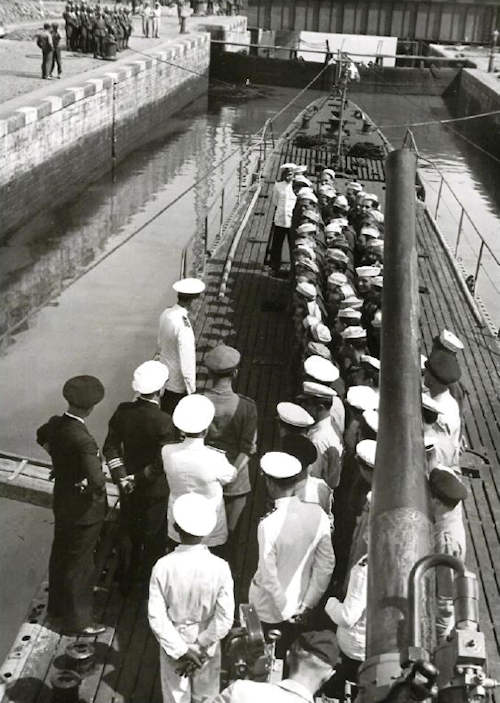
Furthermore, based on the experience acquired in previous oceanic missions and to meet the wishes expressed by each commander, other modifications were made to the false towers of all submarines, to make it easier for personnel to stay on the bridge and to ensure that the lookout service was as effective as possible. It was precisely in the transformations he made to our boats in record time to increase their autonomy and modify their turrets that engineer Fenu showed his best skills, arousing admiration even from Admiral Dönitz. During their stay in the dock, all the work deemed indispensable to put them in the best operating conditions was carried out on the submarines, making appropriate ballast movements and overhauling the shaft lines and all the hull appendages. Particular attention was paid to the heat engines, which were treated in all their organs and equipment, as well as putting the auxiliary engines in the most perfect efficiency.
From a tactical point of view, Polacchini requested the submarine commanders to communicate each sighting of enemy ships with their respective routes, to allow BETASOM to analyze the deviations of enemy traffic. According to the orders of the command, in the event of an encounter with an enemy ship, the submarine had to limit itself to maintaining contact with it, always asking the base for permission to attack. In BETASOM's operational orders, however, the submarine commanders were initially left with a margin of autonomy which would make them free to act on the basis of their own observations and assumptions. Subsequently, when the high command came into possession of useful information on the movement of traffic, the conduct of operations took place under his guidance, transmitting from time to time to the units at sea all the information that the vessel captain Romolo Polacchini believed to be of help and indication to obtain the greatest successes.
Thanks to Polacchini's commitment, the Italian submarines, diverted from the war against merchant convoy traffic in the North Atlantic and diverted to the war against isolated traffic in the Western Atlantic, were finally enabled to achieve notable successes. These were praised not only by MARICOSOM and SUPERMARINA, but also by Admiral Dönitz, who one day asked Polacchini: "How come Italian submarines have recently reached a tonnage of sunk enemy shipping higher than that of German submarines?", and the BETASOM commander replied – obviously joking – "that the Italian submarines were ... better than the German ones!"
The names of the Italian commanders who, coordinated by Polacchini, covered themselves with glory in the battles along the coasts of South America and the western coasts of Africa, have remained in the history of the Italian Navy for their successes, obtained with meager means in the war that best suited their temperament and inclination. Polacchini commented on these flattering results as follows: "The attack on isolated traffic, when it is intense, is the one that gives greater results with fewer risks than those encountered in the war on traffic conveyed under escort; it is always a preferable use, especially for our submarines, given their characteristics construction and the preparation and training of personnel".

Since France was an occupied country, Polacchini was also concerned with organizing an adequate defense against attacks by the resistance, both at the base itself, and at the headquarters of the higher command moved to the Château du Mulin d'Ornon in Gradignan, both in the other Châteaux where the officers stayed and in the so-called “Camping” that is the former school colony with barracks where the non-commissioned officers, sailors and crews of submarines returning from missions were quartered. Bombardment defenses were also improved in the base warehouses and workshops, and in material, torpedo and ammunition depots. The closest collaborators of the new superior commander of the base during its strengthening and its reorganization were the chief of staff, frigate captain Giuseppe Caridi and the flag adjutant, corvette captain Giovenale Anfossi, who also held the position of chief of the operations office.
The relations of the captain of vessel Polacchini with the Großadmiral Dönitz were apparently good but always very formal and Dönitz always considered Italian men and boats to be far inferior to German preparation and technology. Polacchini had perceived this adverse sentiment from Dönitz, but also having good diplomacy skills, he always made the best of a bad situation. Later the results obtained would speak for him.
Only many years after the end of the war, in a letter dated April 1960, in which he provided the journalist Marco Cesarini Sforza with some clarifications on an article in installments published by the weekly "Gente" on the epic of Italian submarines in the Atlantic, he expressed with decision his own regret for Dönitz's unfair opinion of the Italians.

These are his exact words about it: "Re-reading what I wrote, I realized that I had left out a topic which forms the beginning of your article. Yes, in his book Grand Admiral Dönitz was not only unfair, as you wrote, towards Italian submarines, but something more and worse. Certainly on purpose, he wanted to forget the contribution of Italian submarines to the so-called "Atlantic battle", a contribution which, in relation to the number of units employed, was truly remarkable and worthy of the utmost consideration. Dönitz should have remember the many acknowledgments and praises that he bestowed on Italian submarines, their commanders, Admiral Parona and me, verbally and with decorations (two Iron Crosses for me). Instead, he forgot everything! And he just mentioned the name of Admiral Parona, for reasons of personal and family friendship, omitting instead my name, inexplicably, for many and many reasons".
In any case, despite the poor esteem for the Italian ally, Admiral Dönitz did not hesitate in his moment of need to ask Polacchini to send as many submarines as possible about 4.000 miles from the base to rescue the shipwrecked German privateer Atlantis, which on 22 November 1941, while 350 miles off Ascension Island in the South Atlantic, was surprised by the British cruiser HMS Devonshire, while she was refueling the German submarine U126 and was forced to scuttle herself. Also the German supply ship Python, sent there by the German high command together with three U-boats to collect the survivors, was in turn forced to scuttle herself on 1 December, having been intercepted by the British cruiser HMS Dorsetshire while refueling two German U-boats.
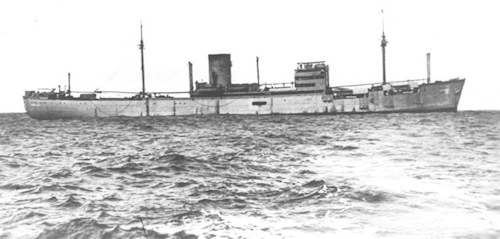 THEAtlantis, famous "pirate ship" of the Kriegsmarine, was an auxiliary cruiser 155 meters long, of 17.600 GRT with a crew of 349 units. She was equipped with: 6 150mm guns; 1 75 mm gun in the bow; 2 twin 37 mm anti-aircraft guns; 2 twin 20 mm anti-aircraft guns; 4 x 533 mm torpedo tubes below the waterline; 92 naval mines in a special compartment.
THEAtlantis, famous "pirate ship" of the Kriegsmarine, was an auxiliary cruiser 155 meters long, of 17.600 GRT with a crew of 349 units. She was equipped with: 6 150mm guns; 1 75 mm gun in the bow; 2 twin 37 mm anti-aircraft guns; 2 twin 20 mm anti-aircraft guns; 4 x 533 mm torpedo tubes below the waterline; 92 naval mines in a special compartment.
At the stern there were 2 150 mm guns hidden by a crane and a fake quarterdeck, the others were behind mobile fake bulwarks inside the superstructures and took the enemy vessels by surprise. He also had a catapult and 2 seaplanes Arado Ar 196 in a hold, one ready to use and the other to be assembled.
In her holds she also carried a large amount of material to modify her structure and blend into the appearance of ships of similar size, but flying the flag of neutral countries. There were a fake smokestack; variable height masts and load peaks; tarps and paint; flags of non-belligerent nations; costumes for the crew. With this material theAtlantis, could adopt up to 26 different silhouettes to deceive the enemy fighter.
The 414 survivors of the two German ships were initially embarked on rafts and lifeboats which were taken under tow by the two U-boats remaining in the area and by two others converged on the spot by the German High Command. Then, on 6 December, the four submarines, each carrying about a hundred shipwrecked men, slowly headed north towards the German bases in France, about 3.000 miles away. However, it was immediately evident that the living conditions on board the four so overcrowded U-boats were almost impossible, both because they could not dive and because of the scarcity of provisions on board.
Admiral Dönitz had to ask for the intervention of the Italian submarines, which he had always despised above all because of the dimensions which he judged too large. Polacchini, not only for the spirit of collaboration but above all for the humanitarian sense that had always distinguished the Italian Royal Navy (and he personally), immediately sent to rescue the submarines Finzi, Tazzoli, Calvi and Torelli which were at BETASOM, after having reduced their crews to the bare minimum so that 70 shipwrecked Germans could each be embarked. The encounter with the four German submarines took place off the Cape Verde Islands between 14 and 18 December, and on our boats 4 survivors of the two sinkings were transhipped (with sea 5-254), who were all placed below deck, to take them to Saint Nazaire.
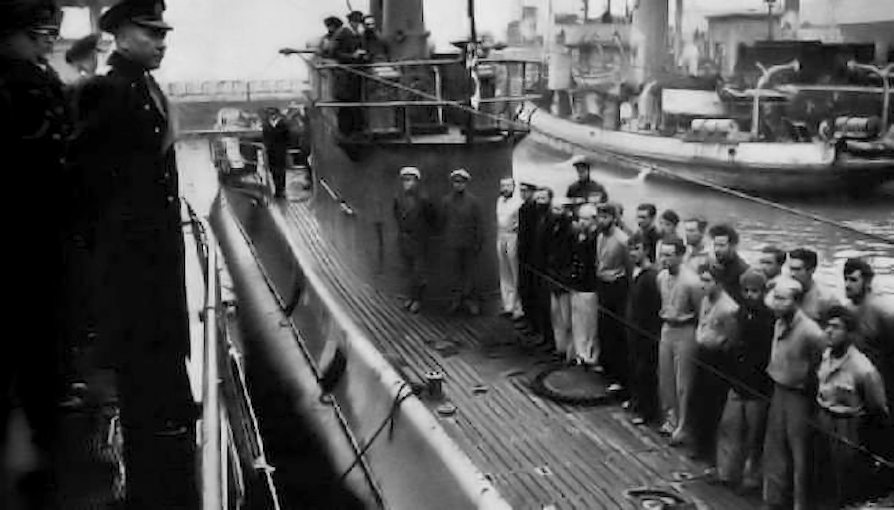
(arrival in Bordeaux of the German shipwrecked on an Italian submarine)
The enterprise carried out by the corvette captains De Giacomo, Fecia di Cossato, Giudice and Olivieri, among the most brilliant rescues on the high seas in history, was much appreciated by Dönitz, who decided to give them the decoration of the Cross of Iron of 1st Class and to Polacchini the Iron Cross of 2nd Class. The official ceremony of delivery of the prestigious honors took place in BETASOM in February 1942.
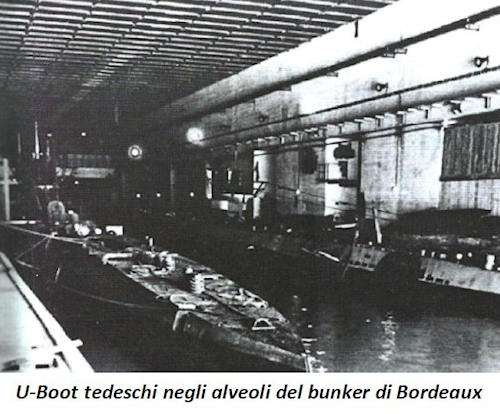 Since the German base in Bordeaux was quite vulnerable to British air attacks, in mid-1941 Admiral Dönitz decided to build a large reinforced concrete bunker in a basin inside the one used by the Italians (bassin à flot n.1). to shelter submarines. This immense construction was begun in September 1941 and lasted a long time, but was operational after a few months. Italian submarines were also often housed in its alveoli, since the request made by vessel captain Polacchini to SUPERMARINA to have its own bunkers was not accepted due to lack of workers and materials.
Since the German base in Bordeaux was quite vulnerable to British air attacks, in mid-1941 Admiral Dönitz decided to build a large reinforced concrete bunker in a basin inside the one used by the Italians (bassin à flot n.1). to shelter submarines. This immense construction was begun in September 1941 and lasted a long time, but was operational after a few months. Italian submarines were also often housed in its alveoli, since the request made by vessel captain Polacchini to SUPERMARINA to have its own bunkers was not accepted due to lack of workers and materials.
In October 1942, with its bunker now usable, the Kriegsmarine set up and deployed in Bordeaux the 12th Unterseebootsflottille, a "Frontflottille" (combat flotilla) of U-boats, under the command of Lieutenant Commander Klaus Scholtz. For the construction of the huge bunker in Bordeaux for the shelter of submarines, the Germans took almost two years, using about 6.000 men, mostly prisoners of war. Built with 600.000 cubic meters of reinforced concrete, the bunker covers an area of 42.000 square meters and has truly impressive dimensions: 245×162 metres. The building is 19 meters high above the water, and has a roof 5,6 meters thick in the area where there are the alveoli to house the submarines. The bunker is divided into 11 cells connected by an internal road. The entrances were protected by thick steel shutters. The 11 alveoli are 14 to 20 meters wide depending on their function: the first 4 were real docks for submarines, while the other 7 were dry docks that could be emptied with powerful pumps. The roof of the reinforced concrete bunker is formed by two layers, with the upper one, 3 meters away from the lower one, made of regularly spaced beams.
This construction system ("fangrost") to face the new and more powerful Allied bombs, made the armor-piercing bombs explode in the space between the two roofs, used as a chamber, rather than penetrating the main bunker below. The demolition of this structure, which effectively resisted air attacks during the war, is practically impossible, and today it has been converted into a museum and venue for exhibitions and cultural events.
Read: "BETASOM's base preparations to operate in the Western Atlantic (part one)"
Photo: web
(article originally published on https://www.ocean4future.org)

